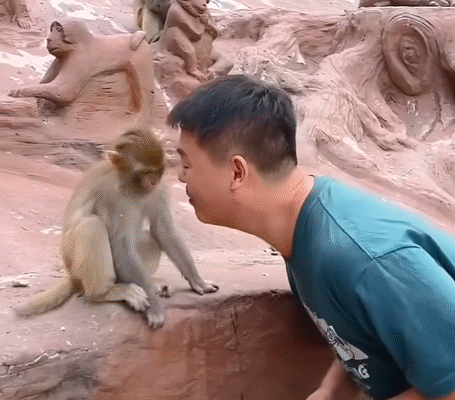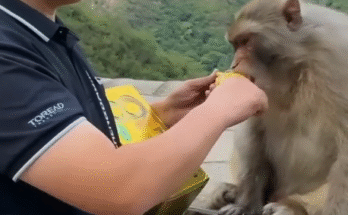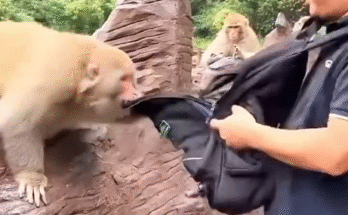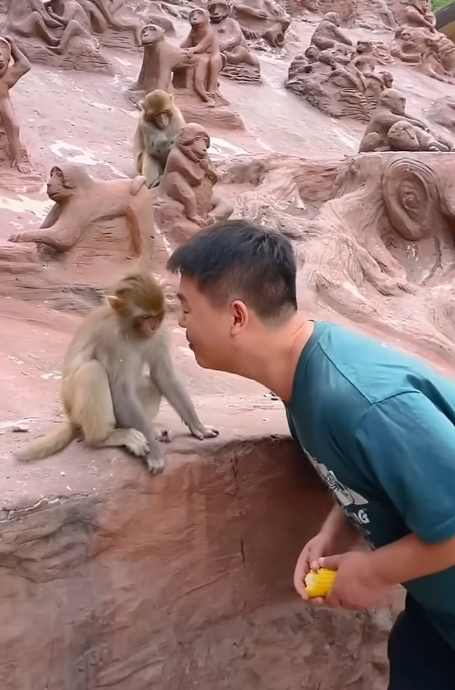
In a quiet village surrounded by dense forests and sparkling rivers, a unique and heartwarming community existed—one where humans and animals lived together in a remarkable harmony. Among the residents was CUTIS, a playful little monkey, who had become famous in the village not only for his antics but for teaching everyone a vital lesson: living with animals requires respect, care, and caution. This village was a living example of how humans and animals could coexist peacefully, enjoying each other’s company while understanding boundaries and safety.
CUTIS, despite his mischievous nature, was extremely intelligent and empathetic. He had learned from a young age that his actions could influence both humans and animals, sometimes in ways that were not safe. For instance, while it was entertaining to see him climb trees or swing from branches, villagers knew that attempting the same stunts could result in injury. CUTIS seemed to understand this instinctively, teaching the community through example. He played with smaller animals, like squirrels and birds, but never chased or harmed them. He helped feed stray cats and dogs but did so gently, respecting their space.
Every morning, the village awoke to the sound of birds singing in the trees and the soft chatter of monkeys playing nearby. The humans would begin their day by tending gardens, preparing food, or doing chores, while the animals roamed freely but respectfully. Children were taught from a young age to watch and learn from the animals rather than imitate risky behaviors. For instance, seeing CUTIS leap between tree branches was fun to watch, but parents would remind their children: “Watch, but do not climb like that. Monkeys are strong, but humans can get hurt.”
One sunny morning, a small crowd had gathered near the riverbank to witness a playful scene. CUTIS was chasing a group of ducks, hopping over stones with astonishing agility. Children watched from a safe distance, laughing at his antics, but none attempted to copy him. Adults stood nearby, smiling, but ready to intervene if necessary. The lesson was clear: observe and enjoy, but do not put yourself in danger by imitating actions you’re not physically equipped for.
CUTIS’s play extended beyond humans. He often interacted with other animals in ways that were both clever and kind. For example, he would help smaller monkeys reach fruits that were too high for them, showing an understanding of teamwork and safety. Similarly, he would gently guide birds that had fallen from nests back to safety. Every action was a lesson in empathy, demonstrating that living in harmony with animals meant caring for them, not merely enjoying their presence.
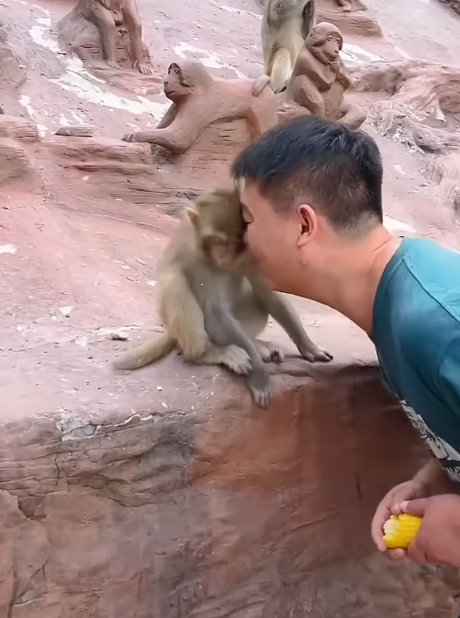
However, CUTIS was not the only animal teaching lessons. The village had a family of elephants that lived nearby, known for their wisdom and calm demeanor. The villagers had learned to respect the elephants’ space, observing from a distance rather than trying to ride or feed them recklessly. Children were fascinated by these gentle giants, but elders always reminded them: “The elephants are kind, but they are strong. Never imitate what you see without understanding the risks.”
One afternoon, a tourist visited the village and was amazed by the interactions between humans and animals. They watched CUTIS and other monkeys play in the trees while dogs ran around happily, and goats grazed peacefully near the fields. The tourist was so inspired that they attempted to climb a small tree like CUTIS to get a better photo. Immediately, a villager called out: “Stop! That’s dangerous!” The tourist froze as CUTIS swung nearby, seemingly nodding in agreement. Within moments, the tourist realized how risky the action could have been and stepped back. The moment became a small but important lesson: animals are agile in ways humans are not, and imitating their movements without caution can lead to accidents.
The village also practiced careful feeding rituals. People would place fruits and grains in designated areas for the monkeys, birds, and other animals. CUTIS and his friends would approach the feeding spots at their own pace, eating peacefully without causing chaos. Children were taught to observe from a safe distance, never rushing toward the animals or trying to force them to eat. This approach ensured that both humans and animals could enjoy food safely and without stress.
One memorable incident involved a large, ripe watermelon that had fallen from a tree. CUTIS approached it with curiosity, tapping and rolling it before eventually nibbling a piece. The children nearby were fascinated but remembered the village rule: “Do not touch or try to roll the watermelon like the monkey. Watch only.” By observing, they learned about balance, strength, and the animals’ natural instincts without putting themselves at risk. CUTIS seemed proud to share the lesson simply by demonstrating safe behavior within his own capabilities.
Respecting boundaries also extended to larger animals. There was a herd of cows that roamed freely in the pastures. Villagers had learned that while these gentle giants were calm, they were powerful and could easily harm someone who approached recklessly. CUTIS would often sit on a small hill near the pastures, observing the cows while keeping a safe distance. Children learned from him that admiration and observation were as valuable as direct interaction.
Harmony in the village wasn’t just about avoiding accidents—it was about fostering compassion. CUTIS often showed affection to smaller animals, like grooming the baby monkeys or cuddling with kittens that wandered close. He was careful not to scratch or bite, understanding that trust and gentleness were the foundation of positive relationships. Villagers, inspired by his behavior, mirrored these actions with care: stroking, feeding, and helping animals without forcing interaction.
The villagers also emphasized teaching rather than scolding. When someone made a mistake, like attempting to chase a monkey or climb a dangerous tree, the elders would gently explain the risks instead of punishing them. CUTIS, in a way, acted as a living teacher, showing through example the right way to interact with nature.
One evening, as the sun set and the sky turned shades of orange and pink, CUTIS and the baby monkeys gathered on the roof of a small shed. They watched the humans preparing dinner in the garden below. Everyone shared a sense of peaceful coexistence. CUTIS hopped down to greet a dog resting nearby, and the dog wagged its tail in delight. Children observed, learning that communication, patience, and respect were key to living alongside animals safely.
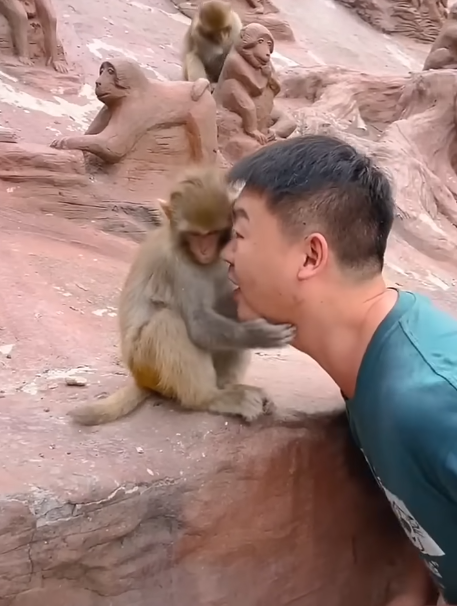
By following these principles, the village had created a remarkable environment. Humans could enjoy the company of animals, and animals could live without fear or harm. It was a delicate balance maintained by rules, observation, and understanding. CUTIS, though small, played a vital role as both entertainer and teacher, showing the importance of patience, caution, and empathy.
The message of the village spread far and wide. Visitors were captivated not only by the playful monkeys but by the harmony between humans and animals. People realized that joy could be found in observing, caring, and interacting safely, rather than imitating dangerous stunts. CUTIS’s lessons became legendary: it was possible to experience the fun and wonder of the animal world without risking harm.
At night, the village would quiet down. CUTIS often curled up near his favorite tree, surrounded by friends—both human and animal. The moon reflected on the river, casting a peaceful glow over the homes and fields. It was a perfect example of coexistence. Everyone knew that by respecting boundaries, observing carefully, and showing compassion, life could be joyful and safe.
And so, the story of CUTIS and the village became a symbol: humans and animals can live in harmony, teaching each other valuable lessons about life, care, and responsibility. The villagers always remembered: watch, admire, learn, but do not imitate dangerous actions. Monkeys, elephants, and other animals had abilities humans did not, and the best way to enjoy their company was through respect, understanding, and empathy.
CUTIS, the tiny monkey with a big heart, continued to inspire the community every day. His playful antics, careful behavior, and loving interactions reminded everyone that living with animals was a privilege—and that harmony was achieved through patience, observation, and safe practices. In this village, humans and animals laughed together, shared meals, and enjoyed the world around them, proving that coexistence was not only possible—it was magical.
And as the night fell, with stars sparkling above, CUTIS nestled in his favorite spot, watching the humans and animals peacefully around him, a soft squeak escaping him in contentment. In that moment, everyone knew: love, respect, and caution could create a world where laughter and safety thrived side by side.
